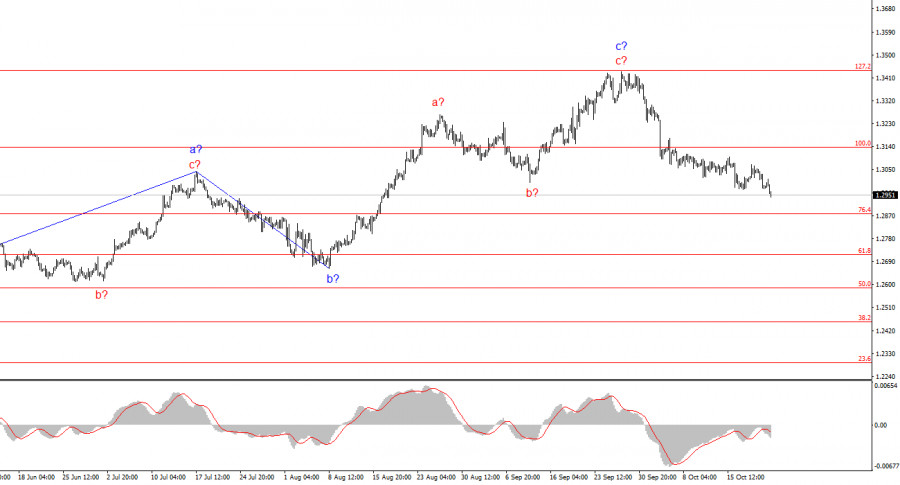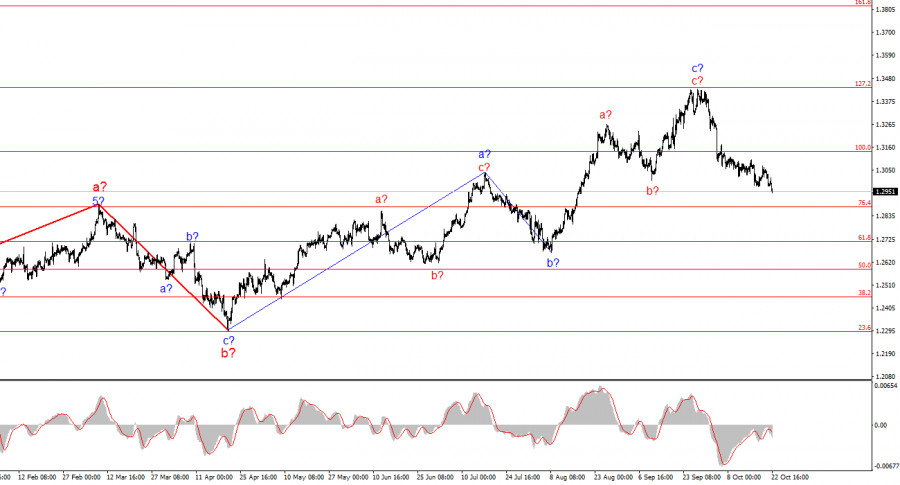

The wave pattern of GBP/USD remains quite complex and continues to extend. For some time, the wave structure appeared convincing, suggesting the formation of a downward wave sequence with targets below the 1.2300 level. However, in practice, demand for the British pound continues to rise, which has disrupted all potential wave formations. Currently, there is a possibility of starting a downward trend segment, but there are still doubts. For example, the rather ambiguous attempt to break through the low of wave B within wave C raises questions.
If, since April 22, we have observed a series of waves a-b-c, with smaller wave sets a-b-c within each, and considering the wave structure of EUR/USD (which suggests the formation of a downward wave set), now would be an opportune time to initiate a new trend segment. However, the pound remains influenced by the Bank of England, which is in no rush to cut interest rates. This allows the pound to decline more slowly. However, when the Bank of England starts signaling readiness to cut rates, the pound could see a more active decline.
The market sees no reason for the downward trend to stop.
The GBP/USD exchange rate remained unchanged throughout Tuesday. During the day, demand for the pound fell again, quite significantly, but towards the evening, the pound managed to recover to the opening levels. However, it is still challenging to find any support for the pound that could help it stop its almost daily decline. There is limited news in the market right now, and no new data is coming from the UK. This week, there should be several speeches by Andrew Bailey, but no corresponding announcements appear in official event calendars. In general, the market receives very little information from the Bank of England. Bailey's recent statements have been contradictory. First, he mentioned that inflation in the UK could accelerate in the second half of 2024, and later, that if inflation decreases, the regulator could cut rates faster. However, there is actually no contradiction here, as there is a time lag of about a month between these statements. Approximately once or twice a month, we receive information from the British regulator.
In contrast, there is a steady flow of information from the Fed. On Monday, Kansas City Fed President Jeffrey Schmid stated that the "cooling" of the US labor market in recent months is not a downturn but a normalization after being "overheated." In other words, the market is returning to normal conditions after extremely low unemployment and record-high employment levels. As we can see, the Fed has been deliberately "cooling" the labor market while also addressing high inflation. There is no crisis in the US labor market; the situation is under control.

The wave pattern of GBP/USD remains complex. The current structure indicates that the trend segment from April 22 may have taken the form of a-b-c, and in this case, it is complete. From the 1.3440 mark, which corresponds to 127.2% Fibonacci, traders could begin opening small sell positions. Currently, traders can wait for a corrective upward wave and then attempt to sell the pair again, but the decline might continue longer within the first wave. Its impulsive nature is now almost beyond doubt. The pair could reach the 1.2800–1.2900 area in the near future.
On a larger scale, the wave structure has transformed. We can now assume the formation of a complex and extended upward corrective structure. At the moment, it is a three-wave pattern, but it could evolve into a five-wave structure, which could take several more months or longer to develop.
Key principles of my analysis:
Wave structures should be simple and clear. Complex structures are difficult to interpret and often change.If there is uncertainty about what is happening in the market, it is better not to enter it.There is never 100% certainty about the direction of movement. Don't forget to use protective Stop Loss orders.Wave analysis can be combined with other types of analysis and trading strategies.